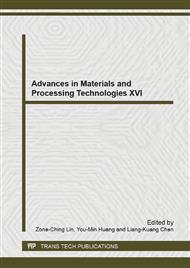[1]
J. Jeswiet, F. Micari, G. Hirt, A. Bramley, J. Duflou, J. Allwood, Asymmetric single point incremental forming of sheet metal, Annals of CIRP—Manufacturing Technology, 54 (2005) 623-649.
DOI: 10.1016/s0007-8506(07)60021-3
Google Scholar
[2]
S.B.M. Echrif, M. Hrairi, Research and Progress in Incremental Sheet Forming Processes, Materials and Manufacturing Processes, 26 (2011) 1404-1414.
DOI: 10.1080/10426914.2010.544817
Google Scholar
[3]
B.T. Araghi, A. Göttmann, M. Bambach, G. Hirt, G. Bergweiler, J. Diettrich, M. Steiners, A. Saeed-Akbari, Review on the development of a hybrid incremental sheet forming system for small batch sizes and individualized production, Production Engineering, 5 (2011).
DOI: 10.1007/s11740-011-0325-y
Google Scholar
[4]
K. Essa, P. Hartley, An assessment of various process strategies for improving precision in single point incremental forming, International Journal of Material Forming, 4 (2011) 401-412.
DOI: 10.1007/s12289-010-1004-9
Google Scholar
[5]
F. Micari, G. Ambrogio, L. Filice, Shape and dimensional accuracy in Single Point Incremental Forming: State of the art and future trends, Journal of Materials Processing Technology, 191 (2007) 390-395.
DOI: 10.1016/j.jmatprotec.2007.03.066
Google Scholar
[6]
J.R. Duflou, B. Lauwers, J. Verbert, Study on the Achievable Accuracy in Single Point Incremental Forming, in, Springer Berlin Heidelberg, Berlin, Heidelberg, 2007, pp.251-262.
DOI: 10.1007/3-540-69845-0_15
Google Scholar
[7]
R. Malhotra, J. Cao, F. Ren, V. Kiridena, Z. Cedric Xia, N.V. Reddy, Improvement of Geometric Accuracy in Incremental Forming by Using a Squeezing Toolpath Strategy With Two Forming Tools, Journal of Manufacturing Science and Engineering, 133 (2011).
DOI: 10.1115/1.4005179
Google Scholar
[8]
J.R. Duflou, J. Verbert, B. Belkassem, J. Gu, H. Sol, C. Henrard, A.M. Habraken, Process window enhancement for single point incremental forming through multi-step toolpaths, CIRP Annals - Manufacturing Technology, 57 (2008) 253-256.
DOI: 10.1016/j.cirp.2008.03.030
Google Scholar
[9]
P.A.F. Martins, N. Bay, M. Skjoedt, M.B. Silva, Theory of single point incremental forming, CIRP Annals - Manufacturing Technology, 57 (2008) 247-252.
DOI: 10.1016/j.cirp.2008.03.047
Google Scholar
[10]
L. Filice, G. Ambrogio, F. Micari, On-Line Control of Single Point Incremental Forming Operations through Punch Force Monitoring, CIRP Annals - Manufacturing Technology, 55 (2006) 245-248.
DOI: 10.1016/s0007-8506(07)60408-9
Google Scholar
[11]
G. Ambrogio, L. Filice, F. Micari, A force measuring based strategy for failure prevention in incremental forming, Journal of Materials Processing Technology, 177 (2006) 413-416.
DOI: 10.1016/j.jmatprotec.2006.04.076
Google Scholar
[12]
A. Petek, K. Kuzman, B. Suhač, Autonomous on-line system for fracture identification at incremental sheet forming, CIRP Annals - Manufacturing Technology, 58 (2009) 283-286.
DOI: 10.1016/j.cirp.2009.03.092
Google Scholar
[13]
A. Fiorentino, Force-based failure criterion in incremental sheet forming, (2013) 1-7.
Google Scholar
[14]
G. Ingarao, G. Ambrogio, F. Gagliardi, R. Di Lorenzo, A sustainability point of view on sheet metal forming operations: material wasting and energy consumption in incremental forming and stamping processes, Journal of Cleaner Production, 29–30 (2012).
DOI: 10.1016/j.jclepro.2012.01.012
Google Scholar
[15]
H. Iseki, An approximate deformation analysis and FEM analysis for the incremental bulging of sheet metal using a spherical roller, Journal of Materials Processing Technology, 111 (2001) 150-154.
DOI: 10.1016/s0924-0136(01)00500-3
Google Scholar
[16]
R. Aerens, P. Eyckens, A. Van Bael, J.R. Duflou, Force prediction for single point incremental forming deduced from experimental and FEM observations, The International Journal of Advanced Manufacturing Technology, 46 (2010) 969-982.
DOI: 10.1007/s00170-009-2160-2
Google Scholar
[17]
M.J. Mirnia, B.M. Dariani, Analysis of incremental sheet metal forming using the upper-bound approach, Proceedings of the Institution of Mechanical Engineers, Part B: Journal of Engineering Manufacture, (2012).
DOI: 10.1177/0954405412445113
Google Scholar
[18]
J.R.D. J. Jeswiet, Alexander Szekeres, Forces in Single Point and Two Point Incremental Forming, Advanced Materials Research, 6-8 (2005) 449-456.
Google Scholar
[19]
J. Duflou, Y. Tunçkol, A. Szekeres, P. Vanherck, Experimental study on force measurements for single point incremental forming, Journal of Materials Processing Tech, 189 (2007) 65-72.
DOI: 10.1016/j.jmatprotec.2007.01.005
Google Scholar
[20]
J. Allwood, D. Shouler, A.E. Tekkaya, The increased forming limits of incremental sheet forming processes, Key Engineering Materials, 344 (2007) 621-628.
DOI: 10.4028/www.scientific.net/kem.344.621
Google Scholar
[21]
B. Avitzur, C.T. Yang, Analysis of Power Spinning of Cones, Journal of Engineering for Industry, 82 (1960) 231.
DOI: 10.1115/1.3663052
Google Scholar
[22]
R. Uppaluri, N. Venkata Reddy, P.M. Dixit, An analytical approach for the prediction of forming limit curves subjected to combined strain paths, International Journal of Mechanical Sciences, 53 (2011) 365-373.
DOI: 10.1016/j.ijmecsci.2011.02.006
Google Scholar
[23]
M. Tisza, Preliminary Studies on the determination of FLD for single point incremental sheet metal forming, Key Engineering Materials, 504 (2012) 863-868.
DOI: 10.4028/www.scientific.net/kem.504-506.863
Google Scholar
[24]
M.B. Silva, P.S. Nielsen, N. Bay, P.A.F. Martins, Failure mechanisms in single-point incremental forming of metals, The International Journal of Advanced Manufacturing Technology, 56 (2011) 893-903.
DOI: 10.1007/s00170-011-3254-1
Google Scholar
[25]
C. Henrard, Numerical Simulations of the Single Point Incremental Forming Process, in, (2009).
Google Scholar


